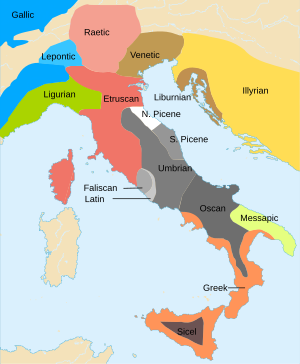Siculian facts for kids
Quick facts for kids Siculian |
|
|---|---|
| Sicel | |
| Region | Sicily |
| Era | attested late 6th century to 4th century BCElinglist |
| Language family |
Indo-European
|
| Writing system | Greek alphabet |
| Linguist List | scx |
 |
|
Siculian (also called Sicel) was an ancient language spoken long ago. It was used by a group of people called the Sicels in the middle and eastern parts of Sicily. Sicily is a large island in the Mediterranean Sea.
Siculian is an Indo-European language. This means it belongs to a huge family of languages. Many languages spoken today, like English, Spanish, and Hindi, are also part of this family. Siculian is no longer spoken; it is an extinct language. We know about it from less than 30 old writings. These writings are from around 600 to 300 years before the Common Era (BCE). We also know about it from about 25 words mentioned by ancient writers.
What Kind of Language Was Siculian?
Historians believe the Siculians came to Sicily from the Italian Peninsula. This happened a very long time ago, possibly around 1300 BCE or 1050 BCE. When they arrived, they moved the people already living there, the Sicanians and Elymians, to the western part of the island.
Most experts today think Siculian was an Italic language. This group includes languages like Latin, which is the ancestor of Spanish, French, and Italian. However, it's hard to be completely sure. This is because we have very few examples of Siculian writing. It's also difficult to understand what the old writings and words mean.
How Do We Know About Siculian?
We know about Siculian from old inscriptions. These are texts carved into stone or pottery. The Sicels used the Greek alphabet for their writing. They also had their own alphabet. This alphabet was based on an old form of the Greek alphabet, especially one used in a place called Euboea.
There are fewer than 30 Siculian inscriptions in total. But only about six of these are clear enough to understand. These six are definitely Siculian. They are not Greek or any other ancient language. These inscriptions give us clues about how the language sounded and what words it used.
Here are some examples of Siculian inscriptions:
ΝΕΝΔΑΣ Π̣Υ̣[----]Σ ΤΕΒΕΓ ΠΡΑΑΡΕΙ ΕΝ ΒΟ[.]ΡΕΝΑΙ ϜΙΔΕ ΠΑΓΟΣΤΙΚΕ ΑΙΤΕ[--]ΛΥΒΕ
nendas ˌ puṛẹṇọṣ ˌ tebeg ˌ praarei ˌ en ˌ bo?renai ˌ vide ˌ pagostike ˌ aite?ṇ?ụbe.
tamuraabesakedqoiaves ˌ eurumakes ˌ agepipokedḷutimbe levopomanatesemaidarnakei- buṛeitaṃomịaetiurela
ΙΑΜ ΑΚΑΡΑΜ ΕΠΟΠΑΣ ΚΑΑΓΙΙΕΣ ΓΕΠΕΔ ΤΟΥΤΟ FΕΡΕΓΑΙ ΕΣΗΕΙΚΑΔ[.]
ΑΛΑ
iamˌakaramˌe?p??asˌkaag?esˌgẹpẹḍ2te?toˌveregai- es? ˌ eka ˌ doara[ịẹạḍ]
nunus ˌ teṇti ˌ mím ˌ arustainam ˌ íemitom ˌ esti ˌ durom ˌ nanepos ˌ durom ˌ íemitom ˌ esti ˌ velíom ˌ ned ˌ emponitantom ˌ eredes ˌ vịino ˌ brtome
See also
 In Spanish: Idioma sículo para niños
In Spanish: Idioma sículo para niños

